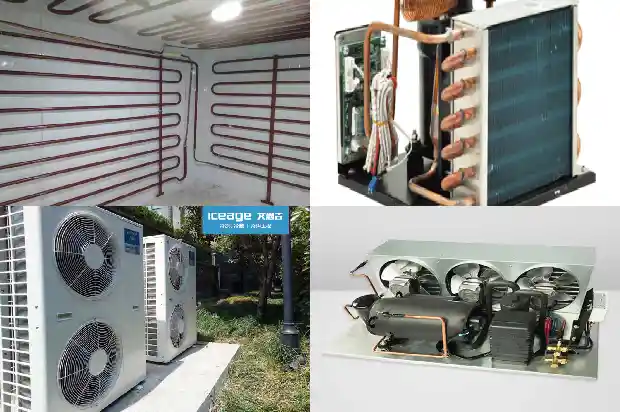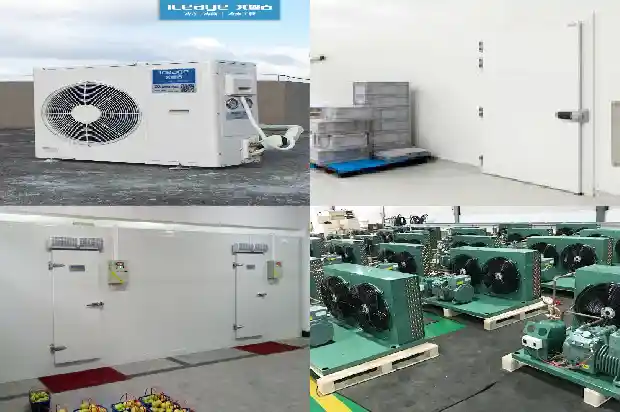Working Principle and Control Logic of Centrifugal Compressor
2024-09-21
- Refrigeration cycle
Centrifugal water chiller belongs to vapor compression refrigeration. Its refrigeration principle is to apply energy to refrigerant vapor through the compressor, so that its pressure and temperature are increased. Then, through condensation and throttling processes, it becomes low-pressure and low-temperature refrigerant liquid. The refrigerant evaporates into vapor in the evaporator. At the same time, it takes heat from the surrounding environment (secondary refrigerant, such as cold water) to reduce the temperature of the secondary refrigerant, thus achieving the purpose of refrigeration. It can be seen that the vapor compression refrigeration cycle includes four essential processes: compression, condensation, throttling, and evaporation. The principles are described as follows:
Compression process: After the refrigerant vapor in the evaporator is sucked in by the centrifugal compressor, the prime mover (generally an electric motor) applies energy to it through the compressor impeller, increasing the pressure of the refrigerant vapor and entering the condenser. At the same time, the temperature of the refrigerant vapor also increases correspondingly at the end of compression.
Condensation process: The high-pressure and high-temperature refrigerant vapor from the compressor releases heat through the cooling water in the tube in the condenser. The temperature drops. At the same time, under the saturation pressure (the condensation pressure corresponding to the condensation temperature), it condenses into a liquid. At this time, the temperature of the cooling water increases because it has taken heat from the refrigerant vapor. The temperature of the cooling water is directly related to the condensation temperature (condensation pressure).
Throttling process: The high-temperature and high-pressure refrigerant liquid from the bottom of the condenser undergoes decompression and expansion when flowing through the throttling device. The pressure and temperature both decrease and turn into low-pressure and low-temperature liquid and enter the evaporator.
Evaporation process: The low-pressure and low-temperature refrigerant liquid evaporates into gas after taking heat from the secondary refrigerant (such as cold water) in the evaporator. At the same time, the temperature of the secondary refrigerant is reduced, thus realizing refrigeration. The refrigerant vapor in the evaporator is sucked in by the compressor again for compression. Repeat the above compression, condensation, throttling, and evaporation processes. In this way, it cycles continuously to achieve the purpose of continuous refrigeration.
Calculation of actual refrigeration capacity of the unit: Actual refrigeration capacity = nominal refrigeration capacity × refrigeration capacity correction factor (where: nominal refrigeration capacity can be found in the performance parameter table of the unit under nominal conditions; refrigeration capacity correction factor can be found in the refrigeration capacity correction curve. The refrigeration capacity of the unit increases as the outlet temperature of chilled water increases and decreases as the outlet temperature of cooling water increases. - Lubricating oil system
The lubricating oil system supplies the necessary lubricating oil for lubricating the main motor, the bearings of the compressor, and the gears of the speed increaser. The lubricating oil in the oil tank is pressurized by the built-in oil pump and enters the oil cooler. After being cooled to a certain temperature (35 °C - 50 °C) here, it passes through the oil filter and then is supplied to each bearing. In order to minimize the leakage of lubricating oil into the main motor and then into the evaporator, comb seals are installed on the inner sides of the bearings at both ends of the motor shaft, and high-pressure gas from the compressor volute is introduced for oil sealing. - Cooling of the main motor and oil cooler
Both the main motor and the oil cooler are cooled by the latent heat of vaporization of liquid refrigerant. This liquid refrigerant is drawn from the bottom of the condenser. Using the pressure difference between the condenser and the evaporator, it is introduced into the interiors of the main motor and the oil cooler to take away the heat generated by the motor and the lubricating oil to cool the motor and the lubricating oil.
The vaporized gas of the liquid refrigerant then enters the evaporator.
- Oil return system
The oil return system separates the lubricating oil mixed in the refrigerant to improve the purity of the refrigerant and sends the separated lubricating oil back to the oil tank. During the operation of the refrigeration unit, a small amount of lubricating oil is mixed into the refrigerant gas of the compressor from the bearings and gearbox of the compressor. After being liquefied with the refrigerant gas, it is dissolved in the condensate and finally flows into the evaporator. On the other hand, at the two bearings of the main motor, the lubricating oil may also enter the inner cavity of the motor, and then enter the evaporator from the motor return pipe along with the refrigerant gas after cooling the motor. All the lubricating oil entering the evaporator through the above two channels does not evaporate. As a result, there will be more and more lubricating oil in the evaporator, and at the same time, there will be less and less lubricating oil in the oil tank.
Since lubricating oil is lighter than liquid refrigerant, in the evaporator, the lubricating oil floats on the upper part of the liquid refrigerant. Therefore, the refrigerant purification device takes the low-temperature mixed liquid from the liquid level of the evaporator and heats it by the high-temperature refrigerant heat source from the condenser to evaporate the refrigerant in the mixed liquid and return it to the compressor inlet. The non-evaporating lubricating oil returns to the oil tank, thus achieving the purpose of separation and purification. - Main control logic
- Start-stop control of chilled water pump
When starting the unit when it is in the shutdown state, the chilled water pump starts 5 minutes earlier than the oil pump. When the unit is in the startup state (including standby), the chilled water pump is always in the startup state. After the unit is shut down normally, the chilled water pump is delayed by 5 minutes to shut down relative to the main motor. If the compressor stops due to fault protection, the chilled water pump is delayed to shut down. - Start-stop control of cooling water pump
When the unit starts, the cooling water pump starts 30 seconds later than the chilled water pump. When the unit is in the startup state (including standby), the cooling water pump is always in the startup state. After the unit is shut down normally, the cooling water pump is delayed by 5 minutes to shut down relative to the main motor. If the compressor stops due to fault protection, the cooling water pump is delayed to shut down. - Capacity regulation operation of compressor
According to the chilled water outlet temperature and the set PID parameters, automatically control the opening and closing of the guide vane and the frequency of the motor (for variable frequency motor) to adjust the compressor capacity and keep the chilled water outlet temperature constant at 7 ± 0.3 °C. Capacity regulation defines the following three actions: where the guide vane opening and motor frequency both refer to output values.
Capacity maintenance: Both the guide vane and the motor frequency are in the maintenance action.
Capacity increase: Increase the opening of the guide vane or increase the motor frequency.
Capacity reduction: Reduce the motor frequency or reduce the opening of the guide vane. - Adjustment method of guide vane
Before the unit starts, the guide vane can be manually opened and closed throughout the whole process to check and adjust the limit switch of the electric actuator and the guide vane opening measurement circuit. After the system is powered on or a start command is issued, the guide vane will automatically close to zero position.
When starting up, whether the guide vane is manually adjusted or automatically adjusted, one of the three guide vane actions is executed in each cycle:
maintenance;
increase the opening of the guide vane;
reduce the opening of the guide vane.
After the guide vane enters automatic operation, it operates between 5% and 100%. The opening of the guide vane must not be less than 5%. After the unit is started and the guide vane automatically opens to 10%, the guide vane can be manually opened and closed between 0% and 100%. At this time, pay attention to observing the chilled water outlet temperature and adjust the opening of the guide vane in time to ensure the normal operation of the unit.
Manual adjustment replaces the capacity adjustment PID algorithm, and all other protections are effective. When the guide vane given control mode is selected and the given value is set, after pressing the OK key, the guide vane will automatically open and close to the given value. When manually adjusting to open and close the guide vane during shutdown, or when performing the shutdown action, the guide vane directly outputs according to the positioning value. - Compressor shutdown
The frequency of the variable frequency motor remains unchanged. The guide vane is gradually closed to 10% (using the feedback opening as the control. If the feedback opening does not reach the 20% position within 20 action cycles, the main motor is directly shut down.). Shut down the main motor, close the guide vane to zero, and delay shutting down the oil pump for 3 minutes. - Control of compressor oil heater
The compressor oil heater is controlled by the oil heating AC contactor.
Ensure that after the compressor stops, the oil tank temperature is maintained between 48 °C and 52 °C. When the unit is started and the oil pump is turned on, the oil heater is disconnected. Otherwise, it operates according to the following conditions:
When the oil tank temperature is ≤48 °C, the oil heater is turned on;
When the oil tank temperature is ≥52 °C, the oil heater is disconnected;
When the oil tank temperature is between 48 °C and 52 °C, the oil heater contactor remains in its state.
When the oil tank temperature sensor fails, the oil heater is turned off and a fault is displayed, but the running main unit does not stop.
Related Articles
- Principles, Components and Heat Recovery of Modular Units
- What are Refrigeration Equipment? What's the Principle of Chillers?
- What Is the Working Principle of Refrigeration Equipment?
- Operating Principle and Standard Installation Steps of Multi - split Systems in Refrigerant Air - conditioning Systems
- Working Principle of AC Inverter and DC Inverter Air Conditioners
- What's the principle and function of air energy?
- Principles of Refrigeration Systems and Functions of Components Explained
- Function and Working Principle of Subcooler
- Fault Analysis of Working Principle of Screw Chiller Unit
- Working Principle of Economizer for Refrigeration Compressor
- Principle of Multiple Storages in One Unit and Evaporation Pressure Regulation Methods
- Principle and Refrigeration Process of Piston Refrigeration Compressor
- Characteristics and principles of air-cooled and water-cooled units
- Air-source heat pump: Principle of cooling and heating in one machine
- Industrial screw water chiller working principle
- Water Cooled Unit Principle of Operation and Parameter Failure Analysis
- The principle of air conditioning refrigeration
- Introduction to Control Valves in Refrigeration Systems
